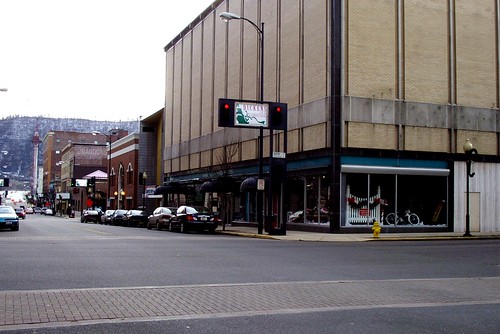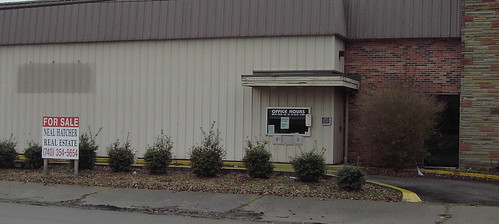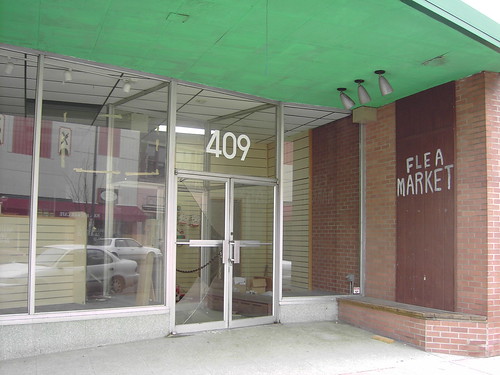
How are downtown Portsmouth and Terri Schiavo alike? Both downtown Portsmouth and Terri Schiavo are in a “persistent vegetative state.” Both downtown Portsmouth and Terri Schiavo have been kept alive for a long time by feeding tubes that provide expensive sustenance for the comatose patient, sustenance paid for by tax-payer dollars. Finally, both downtown Portsmouth and Terri Schiavo have been exploited by cynical politicians and lawyers for political and financial gain.
Downtown Portsmouth has been kept on feeding tubes for so long by lawyers and politicians that the kind of initiative and vision that would be required to revive the patient has been bred out of most local politicians and business people. What a prophet Jesse Stuart turned out to be! (See my Jan. 29, 2004 blog.) The elite of Portsmouth have been on federal, state, and city feeding tubes so long that they have come to think of them not as an artificial temporary support but as the aorta of the local economy. Many local business and professional people have been abated so much they are a bit batty. They have been subsidized so long they are intoxicated by their own dependency, and perhaps nobody more than Neal Hatcher.
To continue the Terri Schiavo analogy, Clayton Johnson is the Bill Frist of Portsmouth. He claims that the downtown can be revived if only we don’t remove the feeding tubes, as long as we don’t cut ourselves off from public funding, as long as we don’t stop the city government from moving in to the empty Marting department store and the empty former Adelphia Cable building.
How do Johnson and his cohorts explain the current dire state of downtown Portsmouth? According to the grim fairy tale he and others began spinning in 1980, and continue spinning twenty-five years later, downtown Portsmouth was about to be restored to its previous robust condition when three malicious councilmen prevented tubes from being hooked up to the area. Why did they do that? What did the councilmen have to gain by allowing downtown Portsmouth to continue in a comatose state? Were there any financial and political gains for them? Their accusers never claimed there were. The councilmen were supposedly just malicious men out to kill downtown Portsmouth.
The councilmen, in turn, claimed that the mall was never a realistic possibility. It was a fantasy, a scheme, a smokescreen, a scam. It was a crooked land grab deal worked out between then city manager Barry Feldman and the local elite. Johnson was an architect of the 1980 mall deal, just as he was of the Marting scam. A front-page story in the Daily Times back on January 23, 1980, described him as “an attorney who was instrumental in helping prepare the shopping center agreement . . . .”
The best evidence that the councilmen were right about the mall being a smokescreen was that the mall never materialized, even though the councilmen were recalled from office within the year and replaced by pro-mall supporters, while Barry Feldman was kept on as city manager. Neither in 1980 or in the twenty-five years since then has a mall ever been built in downtown Portsmouth. We are supposed to believe there was a brief alignment of the planets, back in 1980, and having failed to tap into the public and private monies that were available at that magic moment, the mall could never be built. As recalled City Council member Ann Sydnor explained this alignment of the planets to me, “The recall [of the three councilmen] was successful. They were removed from office. Three people that supported the revitalization of the downtown were appointed to their seats, but by the time this process took place the money had dried up.” If Portsmouth were a realistic site for a mall, why would public and private funds dry up and dry up forever? There will always be public funds as long as there are feeding tubes.
If Johnson had been willing to admit in the beginning that Marting’s was a commercially worthless white elephant, and had arranged to give it to the city in return for the Foundation’s tax relief, he and the Foundation would have some right to a claim of philanthropy, although giving away something that is not only not worth anything to you but is costing you money in the form of taxes, does not make you a Mother Teresa. Johnson was “instrumental,” to use the word used to describe his role in the 1980 mall shenanigans, in subverting Ohio’s Sunshine laws to arrange the outrageous sale of the Marting building to the city for $2,000,000. Having a corrupt mayor and complaisant city council to work with, Johnson got greedy and overreached, and he and the city have been dealing with the political and economic consequences of his poor judgment ever since. The scuttlebutt is that when former mayor Bauer is down in his cups he blames Johnson for the miserable mess that led to the mayor’s recall. So do a lot of other people in Portsmouth.
Clayton Johnson exploits Portsmouth’s romanticized memories of its putatively prosperous past, when Chillicothe Street teemed with shoppers who had real jobs and when Marting’s was the downtown anchor store. Marting’s is the anchor to a past that people want to remember and want to believe can be revived. Playing on people’s nostalgia, exploiting their fond memories and their unrealistic hopes, the Marting Foundation is wrapping their gift to the city in the dearest of downtown memories. “Do not give up on downtown! Do not tear down the Marting building! Do not desecrate the past!” That is the Foundation’s public relations propaganda. Who growing up in Portsmouth in the 1900s did not have some fond experience of buying a Marting’s Christmas or birthday present? I’ve even been told people who might not be able to afford the prices at Marting’s still managed to share in its prestigious name by using a Marting’s box to wrap their gift in. Johnson is now wrapping the past in the Marting building, that undistinguished architectural box, and more recently, since Judge Marshall ruled the sale illegal, is willing to let the empty box go for only the $400,000 he did not return to the city.
And then there is the other Clayton, Johnson's cousin George. It is a shame that somebody did not make living wills for Marting’s and Kenrick’s. Think of how much the taxpayers would have benefited if they did not have to pay for the feeding tubes that are being attached to these private buildings when historic and architecturally important buildings like the N&W terminal and the Municipal Building don’t have a prayer of surviving.
I have made a living will, and if the Marting Building was endowed with consciousness I think it would too. The Marting’s building would be content to survive in the memories of the people who had happy experiences there, and not allow itself to be hooked up to a life-support system that would enable it to survive as a shell of itself when the millions to renovate it could have been spent on a new municipal building.
Terri Schiavo’s parents naturally and understandably cannot give up the hope that she might miraculously recover. They have the pictures of their healthy daughter and their memories to sustain them in their faith, just as we have the floodwall murals as memories of Portsmouth’s mythicized past.
The floodwall murals could not have come into existence and could not continue to exist without the feeding tubes through which it receives public monies. From the start, one of the chief justifications for the floodwall murals was the tourists it would attract. George Clayton’s white elephant properties in Boneyfiddle were purchased to handle the flood of tourists that have not yet come but are still anticipated. The murals have been on the floodwall for about a decade, and the flood of tourists has not materialized. There is at best a steady trickle, but hardly enough to justify the millions of public monies that have already been, and will subsequently be, spent on the project, monies a good part of which will find a way into the pockets of Portsmouth’s over-privileged. “If you build it, they will come,” seems to be the message the Wall supporters spread. Who will be surprised if more historic buildings are torn down and new ones built with the abatements and other perquisites that will flow through the feeding tubes, all to accommodate the anticipated crowds of tourists who will come to see the murals?
Speaking of feeding tubes, 209 Chillicothe Street (pictured below), which is in the next block down from Marting's, offers food for reflection. A pet store struggled to make a go of it at this location before it was vacated to rejoin the number of forlorn empty downtown storefronts. Then a fly-by-night flea market occupied the premises, the hand lettered name of which can still be seen on the wall outside the entrance. The seedy characters who lingered about the flea market added a certain down-and-out authenticity to lower Chillicothe, and we could find some consolation in the fact that if pets could not make a go of it at that downtown location, at least fleas could. But then the flea market flew the coop, leaving a smashed front left door pane, which you can see in the photo below. Parts of Chillicothe St. is beginning to look like John St.
What about feeding tubes? This unprepossessing piece of commercial property was purchased for $45,000 in 1996. In 2005, less than ten years later, in spite of the failed businesses that have occupied it, 409 Chillicothe Street is assessed for $166,390, with improvements of course. And since assessment figures are usually lower than market value, the property is possibly worth appreciably more, on paper at least. How can that be? I suspect there is a feeding tube connected to it somewhere, somehow, because 409 Chillicothe is owned by a Hatcher. If there is any family in Portsmouth who knows about feeding tubes, it is the Hatchers.




